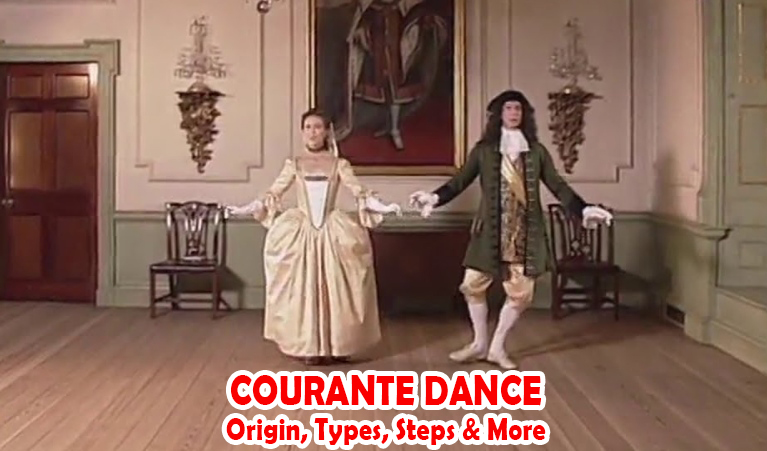The Courante dance (sometimes spelled as Courant) is a court dance originating from the 16th century, late Renaissance and Baroque. It was prevalent in European ballroom scenes as a dance for couples with running steps as its signature.
In a dance suit of Baroque style, Courante will be positioned after an allemande dance and before an optional prelude.
Table of Contents
Courante Dance Origin
In the 17th century, dancing was a crucial part of European society. The name Courante was created during this time for a solemn and noble dance which didn’t compromise the liveliness that could have been there, with French and Italian folks both having credit for it.
However, the records pointed back to an even older origin of Courante, which was likely to be in the 16th century and further. Scholars had a hard time pinpointing whether Courante was entirely French or developed from Italy’s corrente.
In the Baroque period, the group of dancers was called a suite. The opening was usually an allemande (any of the dances from the German court), followed by Courante, and then a sarabande & a gigue, and a couple of dances for a grand ending.
The literal meaning of Courante is “running”, hence the dance was frequently associated with rather quick jumping and running steps during the later period of the Renaissance.
Being hailed as the dance of Kings, the purpose of the Courante dance at first was rather simple, nothing beyond a solemn and graceful performance for the elites.
Nonetheless, as its popularity and impact broadened, it became the epitome of good breeding and decent education at some point.
Types of Courante Dance
French Courante
Researchers believe Courante Françoise originated from ballet before the 1650s, hence it is possibly much older than the French Baroque dances.
During the reign of King Henri II, Courante was widely recognized and highly revered, though its popularity remained within the court and not among the folks. Therefore, records of this time described the dance as majestic and solemn.
According to “The Philidor Collection”, there were a decent number of Courante examples performed in front of other French kings, Charles IX, Henri III, Henri IV, and Louis XIII with the court’s musical ensembles.
Eventually, Courante became so immensely popular that an education would be considered incomplete until the person could master the dance. Furthermore, if someone could dance and sing to Courante, it meant they had good gentility.
The prime time of Courante was under King Louis XIV’s reign, with the King himself performing in court balls.
Consequently, the steps were also at peak solemnity with curtsies and bows starting and ending each segment, and the dancers never lifted their feet from the floor.
The modern French Courante appears in 3/2 rhythms, sometimes changed to 6/4 for a sense of contrast.
Check more: List of French Traditional Folk Dances
Italian Courante
Another opinion is that Courante evolved from a folk dance in Italy. The performance included a wooing pantomime, followed by three couples.
When turned into a court dance, it was performed with smaller steps, with which the dancers could go back & forth or spring off the floor. Nonetheless, as it went on and developed, the little jumps became glides.
During the performance, couples will hold hands as they advance or retreat. As they turned away or faced each other, they would drop their hands.
The most distinctive detail about the Italian Courante was the ¾ and ⅜ rhythms that were more commonly in use. The 8-note running passages also gave the audience the impression that it was more rapid.
How To Dance Courante
Some Courante dance characteristics hardly change regardless of the version we are discussing.
- Rhythm: The tempo is often moderate enough to be distinctive while also highlighting the dancer’s footwork.
- Structure: It can be binary or ternary (two or three parts). There are fragments of music for each section, which can be varied or repeated as long as they get the theme straight out.
- Meter: Courante is usually 3/2 or ¾ because they commend the clear beats and the lively rhythm.
- Melody: Courante mostly uses cheerful songs with a brisk musicality that matches the quintessence of Baroque dance.
- Expression: The main characteristics of Courante are graceful and full of life, so the dancers should be able to showcase a soft and carefree expression.
Pas de courante is the essential move, described as follows.
- Place the left foot at the front and shift your balance to it. At the same time, the right foot is in the fourth position with its heel lifted.
- Extend the right leg to the side while bending down before rising back up and returning the right foot to the fourth, but now with your bodyweight leaned on it instead.
- Move the right leg forward at the same time and let the left foot relax, its heel lifted, and push yourself onto the tip of your right toe.
- Put the entire foot back on the floor to and end the step.
Conclusion
Although no longer as commonly seen and practiced as it was in the old days, the Courante dance was still an essential part of Europe’s culture and history.
It is described in records as the dance of Kings for its role at the court and linked to some of the greatest composers & musicians of the time. Hence, it ultimately became a priceless heritage that people managed to retain until now.

